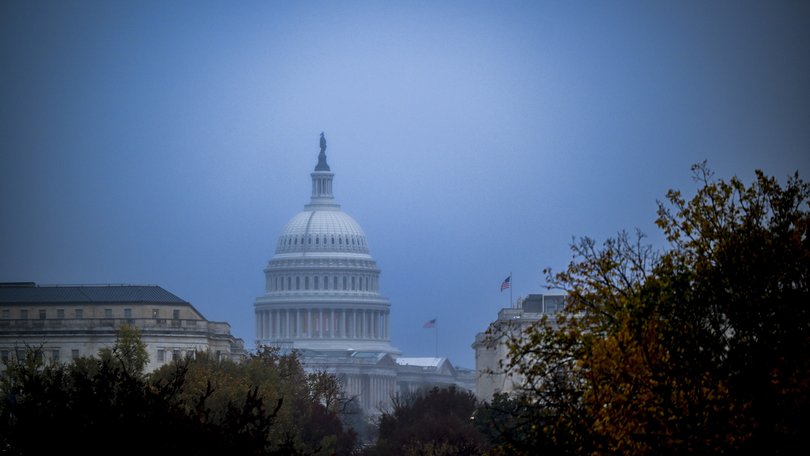Six takeaways from the Senate deal to end the shutdown

WASHINGTON — After more than a month of stalemate, the Senate on Sunday (local time) took a crucial step toward reopening the government, when a small but critical group of Democrats broke from their party and voted with Republicans to advance legislation that would end the longest government shutdown in history
The shutdown is not over yet. Sunday’s 60-40 vote cleared the way for the Senate to formally debate the spending measure before a final vote. If the Senate approves it, the package still must be passed by the House — which has been on an extended recess and has not yet scheduled a return date — and signed by President Donald Trump.
Still, the deal that senators reached Sunday night reflected important lessons for both parties from the shutdown fight and is likely to have far-reaching policy and political implications long after the government grinds back to life. Here are six takeaways.
Sign up to The Nightly's newsletters.
Get the first look at the digital newspaper, curated daily stories and breaking headlines delivered to your inbox.
By continuing you agree to our Terms and Privacy Policy.Democrats’ unity crumbled as the shutdown dragged on
For 40 days, Sen. Chuck Schumer of New York, the minority leader, kept his Democratic caucus unified as a government shutdown stretched into record-breaking territory.
But that discipline couldn’t hold forever, and it broke without Democrats achieving what they insisted was their chief demand in the fight: the extension of health insurance subsidies that are scheduled to expire at the end of the year.
The group of moderate senators who broke from their party said they could no longer hold out on a deal while Americans suffered the consequences of a shuttered government. And they cited a commitment from Sen. John Thune of South Dakota, the Republican leader, that they would at least receive a vote on the tax credits sometime in December.
“This bill is not perfect, but it takes important steps to reduce their shutdown’s hurt,” Sen. Dick Durbin of Illinois, the No. 2 Democrat, said in a statement explaining why he backed the deal.
Still, the promise of a vote does not guarantee that legislation will be passed. In fact, any measure to address health care subsidies faces long odds in a Republican-controlled Congress and given Trump’s frequent broadsides against the Affordable Care Act.
As a result, the deal put bitter Democratic divisions on display. Schumer tersely told reporters that he would not vote for the bill because it lacked health care provisions, and he voiced objections on the Senate floor.
House Democrats, including the minority leader, Rep. Hakeem Jeffries of New York, blasted the deal as insufficient.
“House Democrats have consistently maintained that bipartisan legislation that funds the government must also decisively address the Republican health care crisis,” he said in a statement.
Rep. Ro Khanna of California went a step further, saying that Schumer “is no longer effective and should be replaced.”
“If you can’t lead the fight to stop healthcare premiums from skyrocketing for Americans, what will you fight for?” he said in a social media post.
Health care will stay in the political spotlight
Since Republicans passed a domestic policy package this year that included steep Medicaid cuts, Democrats have focused their attacks against Republicans on the issue of health care, particularly as they eye the midterm elections next year.
Their bid to win health care concessions in the shutdown deal failed. Health care premiums, at least for now, are on track to rise, at a time when Americans say they are worried about paying for medical care.
But the political silver lining for Democrats is that Republicans will now be under pressure to either embrace a measure that could bring down those costs or answer to voters who polls show are overwhelmingly in favour of doing so.
If the agreement holds and the shutdown ends, the spotlight will shift to the vote Thune has promised on whether to extend the health care tax credits, and Democrats made clear that they intend to continue to pressure Republicans on the issue.
“We are going to fight legislatively, fight back home, fight in the courts, and bring this fight in the elections,” Schumer said on the Senate floor. “Health care costs made a major impact on the 2025 election, and they will certainly have an even greater impact on the 2026 election.”
One indicator that Democrats expect the health care fight to define the political debate to come: Every Democratic senator who is running for reelection next year opposed the shutdown deal.
The eight who backed it included senators who could afford to take a political hit, including two who are retiring, Durbin and Sen. Jeanne Shaheen of New Hampshire. Three others — Sens. John Fetterman of Pennsylvania, Catherine Cortez Masto of Nevada, and Maggie Hassan of New Hampshire — are not up for reelection until 2028. And the remaining three don’t face voters again until 2030: Sens. Tim Kaine of Virginia, Jacky Rosen of Nevada and Angus King, a Maine independent who caucuses with Democrats and helped negotiate the deal.
Trump’s pressure tactics worked, even as voters blamed his party
Thune had been offering for weeks to give Democrats a vote on extending the health care subsidies. They only relented after the Trump administration had made the consequences of the shutdown too painful to ignore.
Asked what finally persuaded enough Democrats to break with their party, King offered a simple answer: the harm was growing too acute.
“I think people were saying ‘We’re not going to get what we want,’” on the health subsidies, King said. “But in the meantime, a lot of people are being hurt.”
The group of people affected by the shutdown grew with each week, beyond the hundreds of thousands of federal workers who have not been paid for weeks. The Trump administration’s legal fight to avoid paying SNAP food assistance benefits put tens of millions of Americans at risk of going hungry. And its decision to ratchet back air traffic capacity ensnared millions of others in air travel disruptions and flight cancellations that began over the weekend.
And even though polls showed that voters were generally blaming Republicans more for the shutdown — an assessment Trump said last week that he shared — a handful of Democrats ultimately decided enough was enough.
“We must extend the ACA enhanced premium tax credits, but that can’t come at the expense of the millions of Americans across our country impacted by a shutdown,” Sen. Catherine Cortez Masto of Nevada, who backed the deal, said in a statement.
Trump stayed on the sidelines
Presidents usually want to show that they are taking great pains to end a government shutdown, and that they will force congressional leaders to come to the table and bargain their way out of gridlock.
Not so with Trump.
The president did not once invite Democratic leaders to the White House during the shutdown to negotiate. He did not travel to the Capitol to show that he was leading the way toward a solution.
Instead, he stoked the impasse in social media posts in which he vehemently encouraged Republicans to hold the line, a message he communicated to GOP senators in person at two gatherings at the White House. He cast Democrats as intransigent, and as the consequences of the shutdown mounted, he urged GOP senators to find a way around them, including by ending the legislative filibuster.
As a deal was coming together Sunday night, Trump was at a football game in Maryland, and his sole comment to reporters when he returned to the White House was: “It looks like we’re getting very close to the shutdown ending.” Still, Sen. Markwayne Mullin, R-Okla., said that the White House had given the deal its blessing.
So did Republican leaders
Speaker Mike Johnson led Republicans to pass a stopgap measure to fund the government on Sept. 19. Then, he sent it over to the Senate and told his lawmakers to head back to their districts.
There they have stayed for weeks on end, as Johnson insisted that there was no reason for him or his conference to negotiate, because the House had already done its job. In doing so, he marginalised both himself and his chamber.
Thune, for his part, refused to move from his initial offer: a simple stopgap spending measure that would fund the government at existing levels. Throughout the shutdown, he maintained that Democrats were being unreasonable and that there was no reason to compromise or to tie funding the government to a health care measure.
He ultimately left it to moderates in his party to cut a deal to allow the government to reopen, often sounding more like a spectator than a leader as he professed uncertainty about exactly what deal might be possible when.
The group of negotiators included Sen. Susan Collins of Maine, the Republican chair of the Appropriations Committee, who said she was eager to return to the regular functioning of the congressional spending process.
“Let’s get the job done and let’s do it fast,” she said.
Democrats notched a few gains
Though health care was their major focus, Senate Democrats won some concessions in their fight against the Trump administration’s concerted effort to reconfigure and diminish the federal government.
Their biggest win was language that would restore the jobs of thousands of federal workers who were laid off during the shutdown and bar further reductions-in-force through Jan. 30, while guaranteeing back pay for hundreds of thousands of others who were furloughed, as required by law.
The group of moderate senators that negotiated an end to the shutdown also protected the Government Accountability Office, an agency that helps Congress keep track of federal spending. The GAO has run afoul of Trump and his allies after it twice this year concluded that the president violated rules that prohibit him from unilaterally canceling funding.
The House’s measure proposed to halve funding to the GAO, but the Senate’s measure would keep its funding flat. It also removed language that would bar the agency from suing the White House to release illegally withheld funds.
This article originally appeared in The New York Times.
© 2025 The New York Times Company
Originally published on The New York Times
